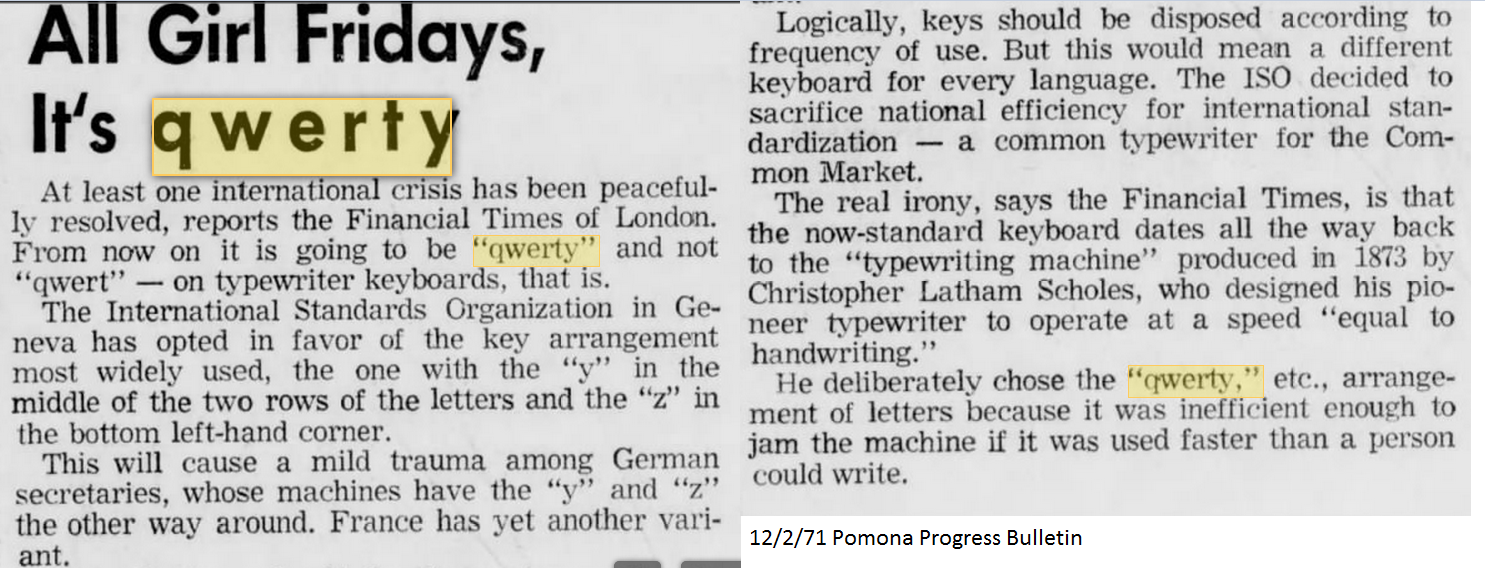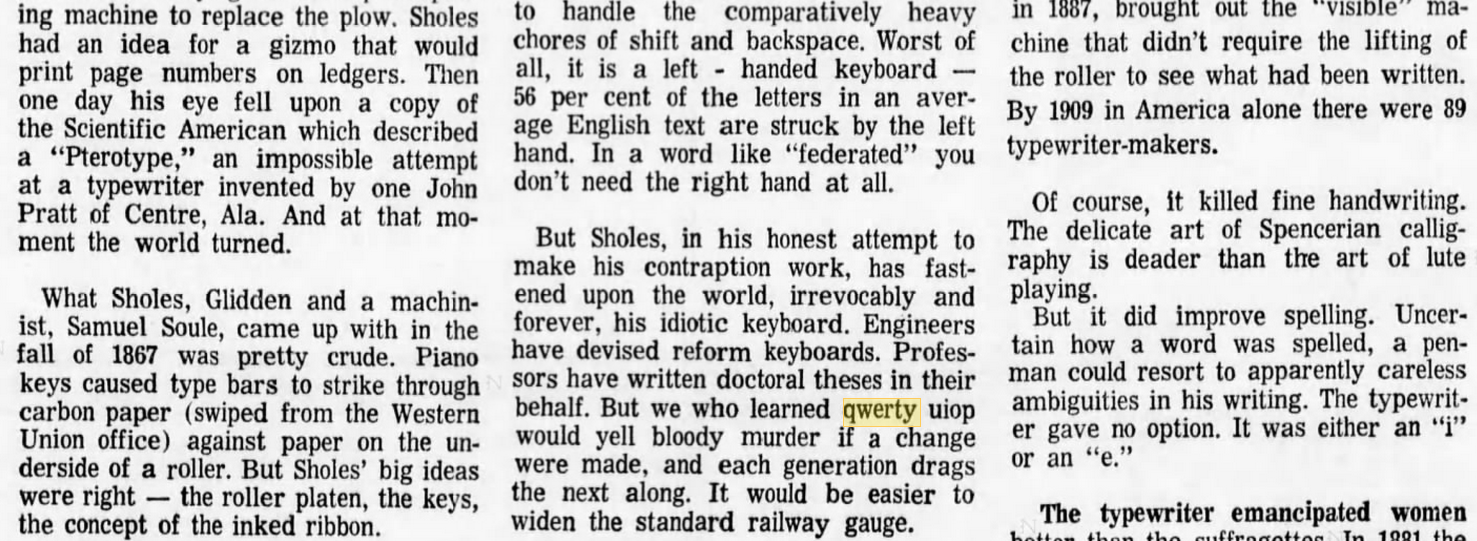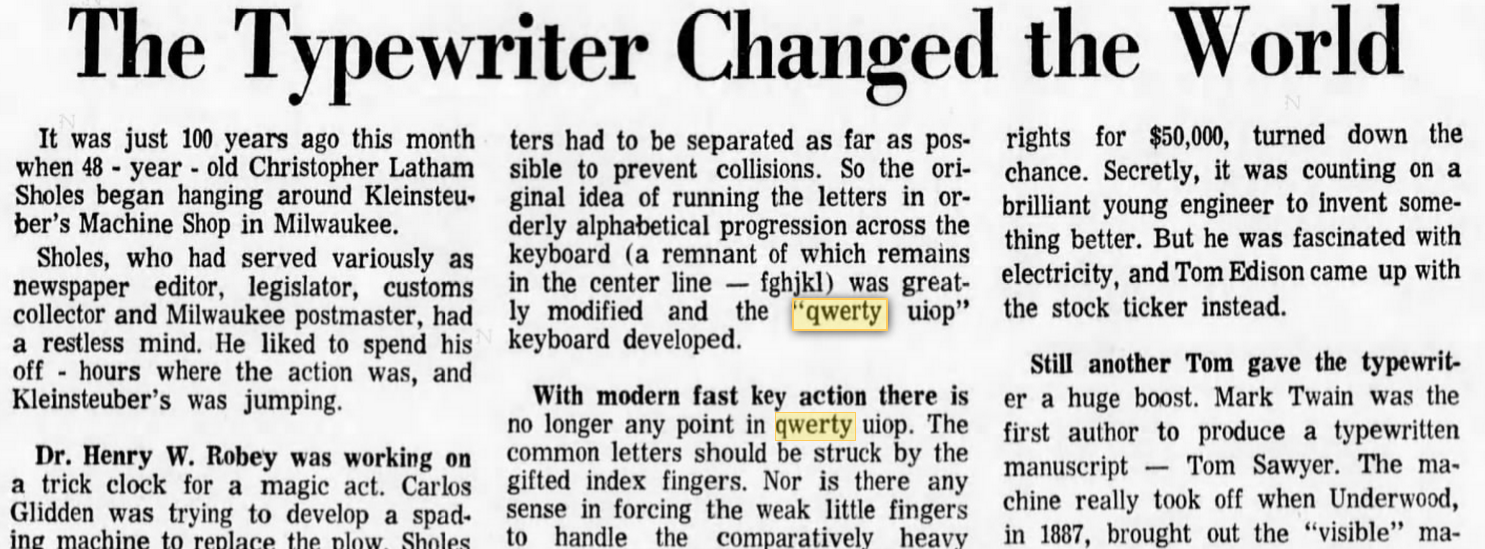Not sure if this article could hold any clues, but perhaps Z could have read it. From the 12/2/71 Pomonoa Press
There is more than one way to lose your life to a killer
http://www.zodiackillersite.com/
http://zodiackillersite.blogspot.com/
https://twitter.com/Morf13ZKS
One more QWERTY article from the 7/2/67 San Bernardino County Sun, these articles show that QWERTY info was available
There is more than one way to lose your life to a killer
http://www.zodiackillersite.com/
http://zodiackillersite.blogspot.com/
https://twitter.com/Morf13ZKS
That’s a remarkably perceptive observation. I’m too young to have familiarity with a typewriter, so I’d have never known. Because you clearly have firsthand knowledge of the history, I’d like to ask a couple questions. How common was it in the 60s/70s to have had formal lessons, so that you’d know of the two-space rule? Does it make certain occupations or past experiences vastly more likely than others? Does it indicate anything about his possible social class/status?
Thanks Finder. I don’t really have good answers to your questions. I can just tell you my experience which is that I took a year of typing in high school back in the ’80s. After about 2-3 months (this is a bit of guess because it’s been so long), I would have had to pay special attention in order to get only one space between sentences.
I went to high school in the ’60’s. Typing classes were offered but not a required subject. More women than men took typing but it was not unusual for men to take the class. There were business colleges, too, where typing would have been a required subject. I still use two spaces between sentences.

Did you guys see that somebody over on Butterfield’s, years ago was posting about Qwerty? http://www.zodiackillerfacts.com/forum/ … f=49&t=617
There is more than one way to lose your life to a killer
http://www.zodiackillersite.com/
http://zodiackillersite.blogspot.com/
https://twitter.com/Morf13ZKS
The problem I see is that, empirically, the 340 appears to be a homophonic substitution cipher (HSC) with one or more nontrivial complexities. So, even if we believe this qwerty line of analysis will provide us with clues, the clues are regarding the symbol assignments, i.e. the HSC aspect of the problem. If the cipher were a straight HSC, we very likely could solve it without any additional clues. What we really need to figure out is the additional complexity part of the problem. It’s pretty unlikely this qwerty analysis will provide us that type of insight.
The value of the pattern isn’t dependent on its utility as a clue to the solution of the 340 or any other cipher. I’ve never, at any time, suggested that it was some remarkable key that’d unlock everything.
I never said you said such a thing, but the claim was definitely intimated by other posters, without much justification, I might add. More to the point, what’s the objective in studying the crude, poorly-constructed 408? To learn about the 340 in the hopes of breaking it. Really, if there were no 340, if the Zodiac had never created it, or any other ciphers, very few people would even bother discussing the 408.
The value lies in the idea that if he did, in fact, apply this pattern, then it offers insight into his background and how he thinks. It, together with other small bits of evidence, might help further characterize the invisible man.
No offense, but even if the Zodiac did use typewriter key adjacency as a means to make his 408, what exactly would that tell you? That the Zodiac had access to a typewriter? And yet millions of people had access to such things in the late 1960s. You can not discern anything more beyond that fact, unless you let your imagination go wild, and to be honest, one thing this "case" certainly does not need is more half-baked launchpads for people to construct even more useless theories. This isn’t Sherlock Holmes and the Zodiac was not Moriarty, although I certainly think many of you imagine you’re playing just such a game.
Regardless, why in the world would the Zodiac use "keyboard adjacency" to make his cipher? Why? It makes no sense, either in the practical or the logical sense. Imagine yourself constructing such a cipher. Now imagine yourself deciding which cipher letters to match to which plain text letters. Would you use "keyboard adjacency"? Who the heck would? Why would you, or anyone else, employ such a ludicrous (and incomplete) means to map your symbols? And then what about all the other symbols?
Plus, looking at your graphics, I see nothing that demonstrates that much. Had you determined that each and every plain text letter mapped to its immediate neighbors, then maybe, but from the images you posted it seems many of the cipher letters are often numerous keys removed from the plain text letter, and it’s a very small keyboard. Even smaller when you exclude all non-letters.
Furthermore, why would it make no sense? We are, each of us, reflections of our environments. We draw from them both intentionally and unintentionally.
Well that’s pretty much given, isn’t it, and yet it would take a lot of intent to use a typewriter to map plain text letters to cipher text letters, which again begs the question: how does that make any real sense? Why would the Zodiac, anyone really, go to such trouble to render more annoyingly difficult what is a very simple task? A child can take all 26 letters and map a number of symbols to each one. I did such in ten minutes using a cipher symbol set of 90+ characters. Why consult a typewriter to ensure that X cipher letter set is bound within some interval around Y plain text letter? And that’s assuming that what you’re claiming is actually demonstrably true.
I think you’ve discovered an artifact that means nothing, like so many other times with respect to the so-called ciphers, and I think you’re projecting your inclination for abstruse problems and solutions onto the Zodiac, a person who never displayed nearly as much inclination for over-complication.
There’s a 1/20 probability that any given plaintext letter has a mean distance below its associated confidence interval. As such, there’s a (1/20)^N chance that N letters have a mean distance below their confidence interval.
Therefore, unless I’m mistaken, the 408’s pattern seems to have odds somewhere around (1/20)^8, or 1 in 25,600,000,000 (rough estimate, but I believe the order of magnitude’s on point).
And this supposed fact has been proven where? On what well-established mathematical foundation is this claim based? And I’m not talking about the basic math within your posts.
The problem I see is that, empirically, the 340 appears to be a homophonic substitution cipher (HSC) with one or more nontrivial complexities. So, even if we believe this qwerty line of analysis will provide us with clues, the clues are regarding the symbol assignments, i.e. the HSC aspect of the problem. If the cipher were a straight HSC, we very likely could solve it without any additional clues. What we really need to figure out is the additional complexity part of the problem. It’s pretty unlikely this qwerty analysis will provide us that type of insight.
Rome wasn’t built in a day! Yes most people who have wrestled with the 340 agree it is likely there is some additional step needed beyond a straight HSC. But in 45 years we have yet to solve any part of the 340, we have not even solved one symbol. This may give us a clue on how to solve the first stage of the 340. Let’s see if we can do that! Then we can see where if anywhere that gets us, and in doing so maybe it leads to ideas for the second stage or additional complexities of the solution.
Ideas need some time to grow. Finder and Doranchak have not yet presented us with their computer study and final numbers. When they do I am sure they will appreciate constructive criticism, questions, suggestions and ideas. But until they present the computer study and final numbers, we don’t even know what exactly they have. But just initially it appears very unlikely to be a chance event and thus is a very promising discovery.
MODERATOR
There’s a 1/20 probability that any given plaintext letter has a mean distance below its associated confidence interval. As such, there’s a (1/20)^N chance that N letters have a mean distance below their confidence interval.
Therefore, unless I’m mistaken, the 408’s pattern seems to have odds somewhere around (1/20)^8, or 1 in 25,600,000,000 (rough estimate, but I believe the order of magnitude’s on point).
And this supposed fact has been proven where? On what well-established mathematical foundation is this claim based? And I’m not talking about the basic math within your posts.
I’m not sure if you’re ignorant of statistics as a study, or if you’re just eager to be bellicose. But it’s "proven" by a very simple argument you seem to have either ignored or not understood. If you simply don’t understand, then let me break it down.
Premise 1) The error bars represent 2 standard deviations from the empirical mean; i.e. there’s only a 5% chance or a probability of 0.05 that each green point lies below the error bars around a blue point.
Premise 2) The probability of a sequence of independent events is the product of the probabilities of each event.
Premise 3) In the 408 key, a green point lies below a blue point 8 separate times.
Conclusion) By premises 1, 2, and 3, the overall probability is 0.05*0.05*0.05*0.05*0.05*0.05*0.05*0.05 = 0.05^8 = 1 in 25,600,000,000.
Do you reject a particular premise? Because each premise has a well-established mathematical foundation (namely the fields of statistics and probability, respectively). Or do you reject the conclusion? If you reject the conclusion, you simply reject logic, in which case any further attempt to convince you of anything is hopeless.
Edit: Another possibility is that you reject the results of the simulation. As AK Wilks has said time and time again, these results are tentative until I have a time to further review the methodology for errors, and until doranchak or others can conduct a peer review. But even if we’re wrong, why so much hostility?
Finder, I’ve found that some people are going to debate you for the sake of debating. Please do press on with your project and don’t get side tracked. ![]()
There is more than one way to lose your life to a killer
http://www.zodiackillersite.com/
http://zodiackillersite.blogspot.com/
https://twitter.com/Morf13ZKS
There’s a 1/20 probability that any given plaintext letter has a mean distance below its associated confidence interval. As such, there’s a (1/20)^N chance that N letters have a mean distance below their confidence interval.
Therefore, unless I’m mistaken, the 408’s pattern seems to have odds somewhere around (1/20)^8, or 1 in 25,600,000,000 (rough estimate, but I believe the order of magnitude’s on point).
And this supposed fact has been proven where? On what well-established mathematical foundation is this claim based? And I’m not talking about the basic math within your posts.
I’m not sure if you’re ignorant of statistics as a study, or if you’re just eager to be bellicose. But it’s "proven" by a very simple argument you seem to have either ignored or not understood. If you simply don’t understand, then let me break it down.
Premise 1) The error bars represent 2 standard deviations from the empirical mean; i.e. there’s only a 5% chance or a probability of 0.05 that each green point lies below the error bars around a blue point.
Premise 2) The probability of a sequence of independent events is the product of the probabilities of each event.
Premise 3) In the 408 key, a green point lies below a blue point 8 separate times.
Conclusion) By premises 1, 2, and 3, the overall probability is 0.05*0.05*0.05*0.05*0.05*0.05*0.05*0.05 = 0.05^8 = 1 in 25,600,000,000.Do you reject a particular premise? Because each premise has a well-established mathematical foundation (namely the fields of statistics and probability, respectively). Or do you reject the conclusion? If you reject the conclusion, you simply reject logic, in which case any further attempt to convince you of anything is hopeless.
As I said, I understand the rather basic math clearly. What I do not understand is where you derived the means by which you arrive at the premise upon which the above math is applied. I just think you’ve made a common mistake: you’ve begun with a junk premise, applied some basic statistical and probability math, and arrived at a junk conclusion, a conclusion that’s not either definitive or inarguable. GIGO.
But whatever. I, and many other people, have seen such posts many, many times, and none of them resulted in anything useful, although, at the time, many people were just as enthusiastic as they are now. In fact, Mike Butterfield’s old board is littered with such dead-ended claims. Neat little math, crisp little graphics and all. And here we are, today, still using computers and simple programming to calculate how many angels can dance on the head of a pin. Such will be the case ten, twenty years from now, as well.
I’m not going to argue further with you. There’s simply no point. You feel you’ve made some important revelation, and now you’re getting defensive because I’ve questioned your claims, which is rather common, not just with people "involved" in the Zodiac case, but with people in general.
Finder, I’ve found that some people are going to debate you for the sake of debating. Please do press on with your project and don’t get side tracked.
It’s called being critical and skeptical. Can you even imagine where the world would be, scientifically and technologically, if every half-baked, hole-riddled, cockamamie idea was given immediate credence?
Einstein’s theory of special relativity was ridiculed for years by the brightest minds on the planet. Einstein then ridiculed quantum mechanics. People laughed at the Wright Brothers. Galileo was forced to recant his science. Darwin was mocked for claiming that humans evolved from monkeys. Global Climate Change is, to this day, debated and often labeled by college-educated citizens and professionals as junk science.
But we’re supposed to unthinkingly accept Ross Sullivan/Richard Gaikowski was the Zodiac and he used typewriter keyboard adjacency to construct his ciphers?
That’s just doubly absurd.
You should be glad some of us are skeptical. It is after all the scientific way, the crucible in which truth, real truth, is forged.
Finder has NOT claimed to have made an important relevation. He simply posted an observation and asked what people think of it. I have made a greater claim of potential importance for his discovery than he has.
Yes the message boards are filled with big claims that subsequently collapsed upon further study. But if you take the attitude that it is impossible that anyone (particularly a new member) could ever possibly discover anything of value about the 340, then why belong to a message board? Why post here? What are we all doing here?
A lot of people told me and Morf that we would never get any unreleased possible Zodiac letters or FBI and police Zodiac files. We tried anyway, and we both got some never before seen stuff, and Morf persisted and got a treasure trove from the FBI. At this board jarlve, quicktrader and others have done some very interesting work on the 340. Many members here are doing good research on new POI’s, ideas and theories. And always it is subjected to friendly skepticism, constructive criticism and good analysis. But we like to let people fully present their ideas before criticize them too roughly.
Yes study, skepticism, criticism and the scientific method are valuable. Doranchak and finder are doing a computer study to examine this theory. Believe me if there is a flaw, a gap, a mistake, a false claim, Doranchak will find it and post it here for all to see.
MODERATOR
As I thought may be the case, the initial results (Thu May 21, 2015 3:15 pm) were off by a constant factor. I corrected the mistake in the code, then re-ran 1,000,000 sequential, randomly permuted simulations. The results are below.
Rather than 8 characters, only six characters (5, 9, 14, 16, 18, and 20) are now at or outside the boundary of their associated 95% confidence intervals. By the same argument as before, such a key has a probability of about (0.05)^6 or, equivalently, odds of 1 in 64,000,000. We make the additional observation that the distances for all but 2 characters (13 and 24) lie below the empirical mean.
If anyone would care to review the code/methodology, I’d be happy to post the code, and I welcome a peer review by knowledgeable members.
Do you reject a particular premise? Because each premise has a well-established mathematical foundation (namely the fields of statistics and probability, respectively). Or do you reject the conclusion? If you reject the conclusion, you simply reject logic, in which case any further attempt to convince you of anything is hopeless.
As I said, I understand the rather basic math clearly. What I do not understand is where you derived the means by which you arrive at the premise upon which the above math is applied. I just think you’ve made a common mistake: you’ve begun with a junk premise, applied some basic statistical and probability math, and arrived at a junk conclusion, a conclusion that’s not either definitive or inarguable. GIGO.
So, then, you reject the code. I am happy to supply you with it if you’d like to review it. If you don’t, then your criticism has no basis in fact, only speculation.




